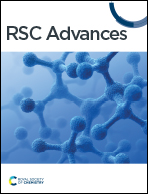Evidence of a reversible redox reaction in a liquid-electrolyte-type fluoride-ion battery†
Abstract
Fluoride-ion batteries (FIBs) have received significant attention as promising alternatives to conventional lithium-ion batteries, but a reversible redox reaction has not been confirmed yet for liquid-electrolyte-type FIBs. We conducted ex situ X-ray diffraction and energy dispersive X-ray analyses for a conventional full-cell assembly of FIBs, in which BiF3, a Pb plate (or Pb powder), and tetraethylammonium fluoride dissolved in propylene carbonate were used as the positive electrode, negative electrode, and liquid electrolyte, respectively. A FIB using a Pb plate exhibited a flat operating voltage at ∼0.29 V during the discharge reaction with a discharge capacity of ∼105 mA h g−1. The reversible electrochemical reaction was, however, attained when the discharge and charge capacities were controlled to be less than 20 mA h g−1. In a such capacity-limited cycle test, Bi and PbF2 phases were formed during the discharge reaction, while BiF3 and Pb phases were generated during the charge reaction. Therefore, a reversible movement of F− ions between the BiF3 and Pb electrodes, i.e., reversible redox reaction was firstly confirmed for the liquid-electrolyte-type FIB. We also attempted to improve the reversibility at the first cycle by replacing the Pb plate with Pb powder electrodes, and consequently, the FIB using an annealed Pb powder indicated the best electrochemical performance.



 Please wait while we load your content...
Please wait while we load your content...